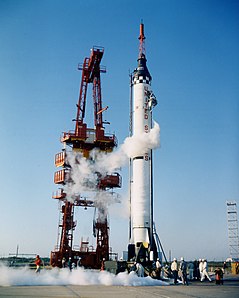Cape Canaveral Air Force Station Launch Complex 5

Mercury-Redstone 1 at LC-5 in 1960
|
|||||||||||||
| Launch site | CCAFS | ||||||||||||
|---|---|---|---|---|---|---|---|---|---|---|---|---|---|
| Location | 28°26′22″N 80°34′24″W / 28.43944°N 80.57333°WCoordinates: 28°26′22″N 80°34′24″W / 28.43944°N 80.57333°W | ||||||||||||
| Short name | LC-5 | ||||||||||||
| Operator | U.S. Air Force | ||||||||||||
| Launch pad(s) | One | ||||||||||||
|
|||||||||||||
| Launch history | |
|---|---|
| Status | Demolished |
| Launches | 23 |
| First launch | 19 July 1956 |
| Last launch | 21 July 1961 |
| Associated rockets |
Jupiter-A Jupiter-C PGM-19 Jupiter Juno I PGM-11 Redstone Juno II Redstone MRLV |
Launch Complex 5 (LC-5) was a launch site at Cape Canaveral Air Force Station, Florida used for various Redstone and Jupiter launches.
It is most well known as the launch site for NASA's 1961 suborbital Mercury-Redstone 3 flight, which made Alan Shepard the first American in space. It was also the launch site of Gus Grissom’s Mercury-Redstone 4 flight. The Mercury-Redstone 1 pad abort, Mercury-Redstone 1A, and Mercury-Redstone 2, with chimpanzee Ham aboard, also used LC-5.
A total of 23 launches were conducted from LC-5: one Jupiter-A, six Jupiter IRBMs, one Jupiter-C, four Juno Is, four Juno IIs and seven Redstones. The first launch from the complex was a Jupiter-A on July 19, 1956 and the final launch was Gus Grissom's Liberty Bell 7 capsule on July 21, 1961.
LC-5 is located next to the Air Force Space & Missile Museum. The original consoles used to launch the Mercury-Redstone rockets are on display in the blockhouse. As of 2011[update] a tour of the blockhouse (and the museum) can be arranged through the Kennedy Space Center Visitor Complex's "Cape Canaveral: Then and Now" tour. One tour is offered daily, so the number of visitors is limited by the size of the tour.
...
Wikipedia
